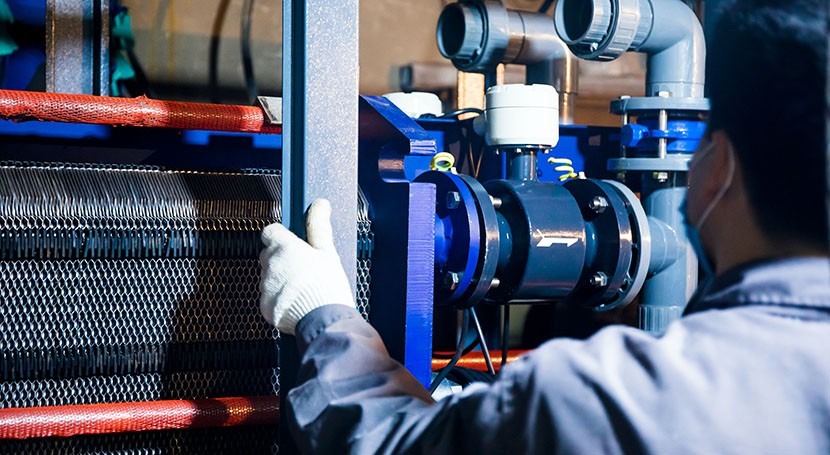Climate change and water scarcity are among the top challenges the world is facing, and the water sector has a double challenge in the face of climate change.
First, there’s the need to be more efficient in water extraction and distribution by reducing energy consumption and prioritizing the use of clean energy.
Second, there’s the need to encourage more efficient water use for both agricultural and urban sectors through public awareness campaigns and improved leakage management techniques.
Ultimately, we must create a resilient and sustainable water supply for people and industries everywhere.
Schneider Electric aims to make the Industries of the Future eco-efficient, agile, and resilient through open, software-centric universal automation. We believe the future of water and wastewater must be more digital and electric. Digital is the enabler for efficiency, and electricity is the best vector for decarbonization.
4x efficiencies
Desalination has become a more important water resource as climate change creates stresses for more traditional surface and groundwater sources. According to the World Economic Forum, some countries in the Middle East already depend on technology for up to 90% of their drinking water supply.
Desalination plants, though, are expensive endeavors, and keeping one running requires balancing multiple goals, including minimizing the risk of downtime, reducing the cost of O&M, and optimizing asset performance.
Digital technologies can play a major role in helping desalination operators and asset owners maximize their value. To drive a holistic view of their assets, operations, people, and resources, Schneider Electric partners with customers to strategize and deploy a step-by-step digital transformation initiative. This plan can start small to fit a customer’s current status in terms of digital readiness while still offering plenty of room to expand, with a line-of-sight on where they should land. Ultimately, this effort drives efficiency, sustainability, and resilience.
We strongly believe that efficiency is an anchor term here. From our perspective:
- Integrating energy and automation is a key enabler in maximizing the operational value of a desalination plant. With EcoStruxure™ for Water and Wastewater, we bring the power of the Internet of Things (IoT), the process, and power-domain expertise to create one architecture, allowing operators to have full control of their assets. Integrating energy and automation can drive up to 20% production efficiency improvement and 30% energy saving.
- Lifecycle management can boost operating efficiency. This should begin at the very early stage of design and engineering and continues through construction and commissioning and into operation and maintenance. What is designed with efficiency in mind can be easily operated similarly. Working with our independent software partners, we drive efficiency and sustainability across the lifecycle. These include AVEVA, its extensive portfolio covering industrial and process assets, and a suite of energy management software vendors like ETAP covering the power assets. Our customers typically leverage up to a 20% reduction in the total cost of ownership (TCO) and a 30% reduction in maintenance cost, thanks to total lifecycle management.
- Integrating IoT endpoints to the cloud without compromising cybersecurity can create greater efficiency. Many major utilities have started to consider the power of the cloud to unlock the potential of big data, artificial intelligence (AI), and analytics. Most of them are considering a private cloud model, but soon this approach will evolve into hyperscale public and/or hybrid cloud. This endpoint integration to the cloud is at the core of our EcoStruxure architecture and can drive up to 25% operational efficiency.
- Integrated company management, or a “Unified Operations Center (UOC),” for optimized visibility efficiency. This aspect focuses on transforming our customers from site-by-site management to integrated company management. Most of our desalination customers, specifically developers or end users, have a portfolio of desalination assets. These assets are scattered, but most are connectable in some way or another. When we connect these plants, our customers get a better picture of what those plants consume, what they produce, where there are efficiency gaps, and what operational matrices and KPIs are needed for better-informed decisions based on data. With this approach, they typically achieve up to 20% improvement in their operational efficiency and a 10% reduction in OpEx.
Improving visibility
With the evolution of IoT, every device is gaining new intelligence, and every piece of equipment plays a dual or triple role. Think about a variable frequency drive (VFD) running a high-pressure pump – now it can tell us much more than simply the pump status and speed because the VFD is now acting as a sensor. It can give us full visibility on energy consumption, the performance point, and even asset management data.
Now generating a huge amount of data, this device is connectable to the automation system at the edge, directly to the cloud, or both. When we scale this approach, customers start realizing the value of data to better manage energy use. Operators can simulate and design their dynamic energy performance with a powerful data analytics backbone. That is one of many outcomes a plant’s digital twin can bring to the operation. A real-time control system can achieve much more than just measurement. It goes up to the prediction, simulation, and automation levels based on multiple parameters.
When we correlate energy data with operating conditions like temperature, salinity, and demand, along with production data, we start to see the power of data analytics. This technology provides a key measure of how much energy you consume versus how much you produce. And you can scale this view on a digital twin to predict, simulate, and run endless what-if scenarios.



